CZ Museum’s Deco Logo For The 21st Century
Posted by: Loren Coleman on November 14th, 2007
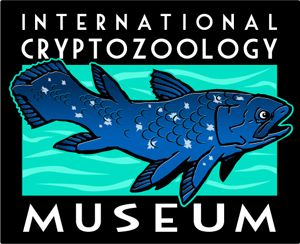
The International Cryptozoology Museum (ICM) continues its evolving development, and today announces the launch of its new logo.
Designed by award-winning branding and marketing designer Duncan Hopkins of iTaggit, who has a subspeciality in cryptozoology work, this logo becomes the icon of the ICM. The design proudly displays as its centerpiece a symbolic representation of the first coelacanth discovered in 1938.

The story of the coelacanth, a fish ethnoknown to the locals as the gombessa or mame, ranks as one of the “darlings of cryptozoology,” along with other discovered species such as the okapi, the giant squid, the mountain gorilla, the giant panda, the saola, and the dwarf killer shark.

The coelacanth (Latimeria chalumnae) is today romantically called a “living fossil,” due to the fact it is a fish thought to have been extinct for sixty-five million years. For cryptozoology, it is a realistic symbolic of extinction, rediscovery, conservation, and awareness. The logo projects an image example of the passion and patience involved our field.
For me, linked to a museum, the coelacanth is also symbolic on another level too.

If not for the curiosity and collecting done by Marjorie Courtenay-Latimer, the curator of East London, South Africa’s small museum, the world would never have learned of the remarkable coelacanth.
On December 23, 1938, Hendrik Goosen, the captain of the trawler Nerine returned to the harbor at East London after trawling near the mouth of the Chalumna River, and called Ms. Courtenay-Latimer to look over his catch. She found the coelacanth in the fish pile, what she felt was a beautiful fish, and the rest is history. She had discovered the coelacanth when she matched it in a book, and had her finding confirmed formally later.
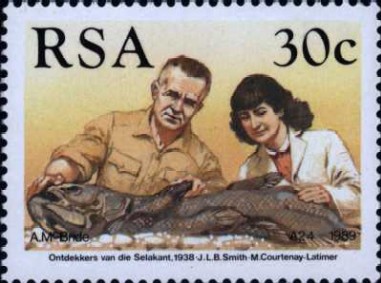
Marjorie Courtenay-Latimer (February 24, 1907 – May 17, 2004) had almost been lost to the world of nursing, but luckily for cryptozoology, she was hired to be the museum’s curator in August 1931, at the age of 24, soon after her nurse’s training. When Marjorie Courtenay-Latimer took over the museum, its exhibits consisted of a bottled piglet with six legs, six stuffed birds which were so full of parasites that she had to burn them, 12 pictures of East London and 12 prints of Xhosa War scenes.

As chance would have it, in November 1936, she and her parents visited Bird Island, off the East Cape coast, where she collected natural history specimens and birds’ eggs. She also was able to go to sea on the trawler Nerine, making friends with Captain Goosen, who promised to save intriguing fish from his trawl nets for her attention. That November meeting resulted directly two years later in the discovery of the coelacanth.
November has always been a good month for cryptozoology.
It was in November of 1900, in another museum setting, when Dr. P. L. Sclater, secretary of the Zoological Society of London, pried open a diplomatic pouch coming from the Congo, sent by Sir Harry Johnston.
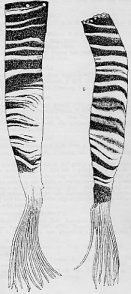
It contained two strips of brown and white striped skin (above); they were bandoliers made by native soldiers from an unknown animal. The skin was the evidence, followed with skulls, that would produce the formal announcement of the okapi in February 1901.
The first megamouth shark was captured on November 15, 1976, about 25 miles off the coast from Kaneohe, Hawaii. The little known shark is today represented by only 39 specimens.
In November 2000, a group of divers discovered three coelacanths off the northeast coast of South Africa, in Sodwana Bay, part of the St. Lucia Marine Protected Area, far from the Comoros. A separate, living population, not just “strays” from the Comoros, had been discovered in South Africa. It was the first population found outside of the Comoran archipelago in the western Indian Ocean and outside of Indonesia.
The coelacanth, within the logo of the International Cryptozoology Museum, therefore symbolizes both the animals and the people involved in this quest.

Also, the logo, in the design and lettering, harks back to a 1930s look, from the days of the coelacanth’s discovery in 1938, to an extension of the popular cultural image of adventurous fedora-wearing cryptozoologists out in the rainforests and montane wilds of the world searching for cryptids. It has definitely been envisioned as an Art Deco icon for the 21st Century.

The youth and adults interested in cryptozoology, inspired by the example of the coelacanth and the curious nature of Marjorie Courtenay-Latimer, will find a home and focus in the work of the ICM.
The Duncan Hopkins-designed logo of the International Cryptozoology Museum proudly meets the world.
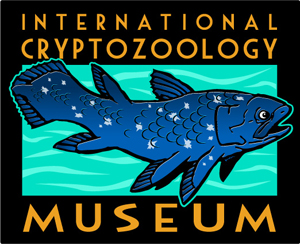
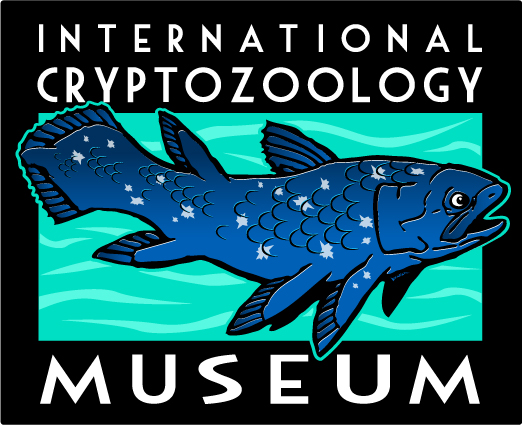
About Loren Coleman
Loren Coleman is one of the world’s leading cryptozoologists, some say “the” leading living cryptozoologist. Certainly, he is acknowledged as the current living American researcher and writer who has most popularized cryptozoology in the late 20th and early 21st centuries.
Starting his fieldwork and investigations in 1960, after traveling and trekking extensively in pursuit of cryptozoological mysteries, Coleman began writing to share his experiences in 1969. An honorary member of Ivan T. Sanderson’s Society for the Investigation of the Unexplained in the 1970s, Coleman has been bestowed with similar honorary memberships of the North Idaho College Cryptozoology Club in 1983, and in subsequent years, that of the British Columbia Scientific Cryptozoology Club, CryptoSafari International, and other international organizations. He was also a Life Member and Benefactor of the International Society of Cryptozoology (now-defunct).
Loren Coleman’s daily blog, as a member of the Cryptomundo Team, served as an ongoing avenue of communication for the ever-growing body of cryptozoo news from 2005 through 2013. He returned as an infrequent contributor beginning Halloween week of 2015.
Coleman is the founder in 2003, and current director of the International Cryptozoology Museum in Portland, Maine.










That would make a cool t-shirt
The coelacanth makes an excellent choice for the museum’s logo. Visually striking and meaningful. If only I knew how to pronounce it. 🙁
Beautiful logo! Is the official one the version with the gold or the white lettering? Both are great.
Coelacanth is pronounced SEE-la-canth.
Which do people like, the gold or the white lettering?
Excellent design, Loren, and the see-la-canth a very appropriate choice of symbols to geneate the greatest credibility – the white-lettering version reads more clearly when greatly reduced, but they are both dynamic and professional looking.
Congratulations!
Now, about those tee-shirts and other items…
http://www.cafepress.com/cp/info/sell/, perhaps?
I like them both, Loren. Beautiful art, thanks for giving us this preview.
I think the gold lettering would look great on an all-black background, like a shirt or mug. The white would look great on a an all-white background.
I love the logo Loren. Thanks for this. I’m so thankful for your dedication to cryptozoology. It keeps me diving, hiking and ever vigilant for the unusual.
I’m a designer myself (Industrial, with some experience in graphic) and the choosing of the coelacanth was a great idea. I like the typography too, although I personally would have made something a liiitle bit more abstract with the coelacanth. It looks really nice, but it would be expensive to portray in things like coffee mugs and the like, on account of all the inks used, and difficult to print if there are restrictions of color…
But it’s a nice logo 🙂
Neat design! And I agree: T-shirts with that logo would be cool.
The coelacanth is classic. I agree on a t-shirt it would be perfect.
And now that we mention it, how about coffee cups and baseball caps and the whole array o’ stuff?
Maybe you need a CRYPTOMUNDO Creature Logo, and that whole array o’ stuff, too!
Let’s see, which Creature would it be? Hmmm…
The coelacanth should be wearing a fedora!
I myself like the gold lettering. And as everybody says, this would make a great shirt.
I like the gold lettering best. If I had a t-shirt with this design, I would add rhinestones in the white patches on the fish and probably one in his eye. What can I say? This one deserves to be flashy!